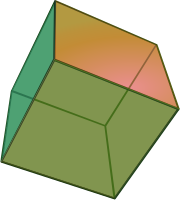
Back مكعب فائق Arabic Гіперкуб BE Хиперкуб Bulgarian Hipercub Catalan Nadkrychle Czech Гиперкуб CV Hyperkube Danish Hyperwürfel German Υπερκύβος Greek Hiperkubo EO
In geometry, a hypercube is an n-dimensional analogue of a square (n = 2) and a cube (n = 3); the special case for n = 4 is known as a tesseract. It is a closed, compact, convex figure whose 1-skeleton consists of groups of opposite parallel line segments aligned in each of the space's dimensions, perpendicular to each other and of the same length. A unit hypercube's longest diagonal in n dimensions is equal to .
An n-dimensional hypercube is more commonly referred to as an n-cube or sometimes as an n-dimensional cube.[1][2] The term measure polytope (originally from Elte, 1912)[3] is also used, notably in the work of H. S. M. Coxeter who also labels the hypercubes the γn polytopes.[4]
The hypercube is the special case of a hyperrectangle (also called an n-orthotope).
A unit hypercube is a hypercube whose side has length one unit. Often, the hypercube whose corners (or vertices) are the 2n points in Rn with each coordinate equal to 0 or 1 is called the unit hypercube.
- ^ Paul Dooren; Luc Ridder (1976). "An adaptive algorithm for numerical integration over an n-dimensional cube". Journal of Computational and Applied Mathematics. 2 (3): 207–217. doi:10.1016/0771-050X(76)90005-X.
- ^ Xiaofan Yang; Yuan Tang (15 April 2007). "A (4n − 9)/3 diagnosis algorithm on n-dimensional cube network". Information Sciences. 177 (8): 1771–1781. doi:10.1016/j.ins.2006.10.002.
- ^ Elte, E. L. (1912). "IV, Five dimensional semiregular polytope". The Semiregular Polytopes of the Hyperspaces. Netherlands: University of Groningen. ISBN 141817968X.
- ^ Coxeter 1973, pp. 122–123, §7.2 see illustration Fig 7.2C.


